Inside the rise of police department real-time crime centers
Police departments want to know as much as they legally can. But does ever-greater surveillance technology serve the public interest?
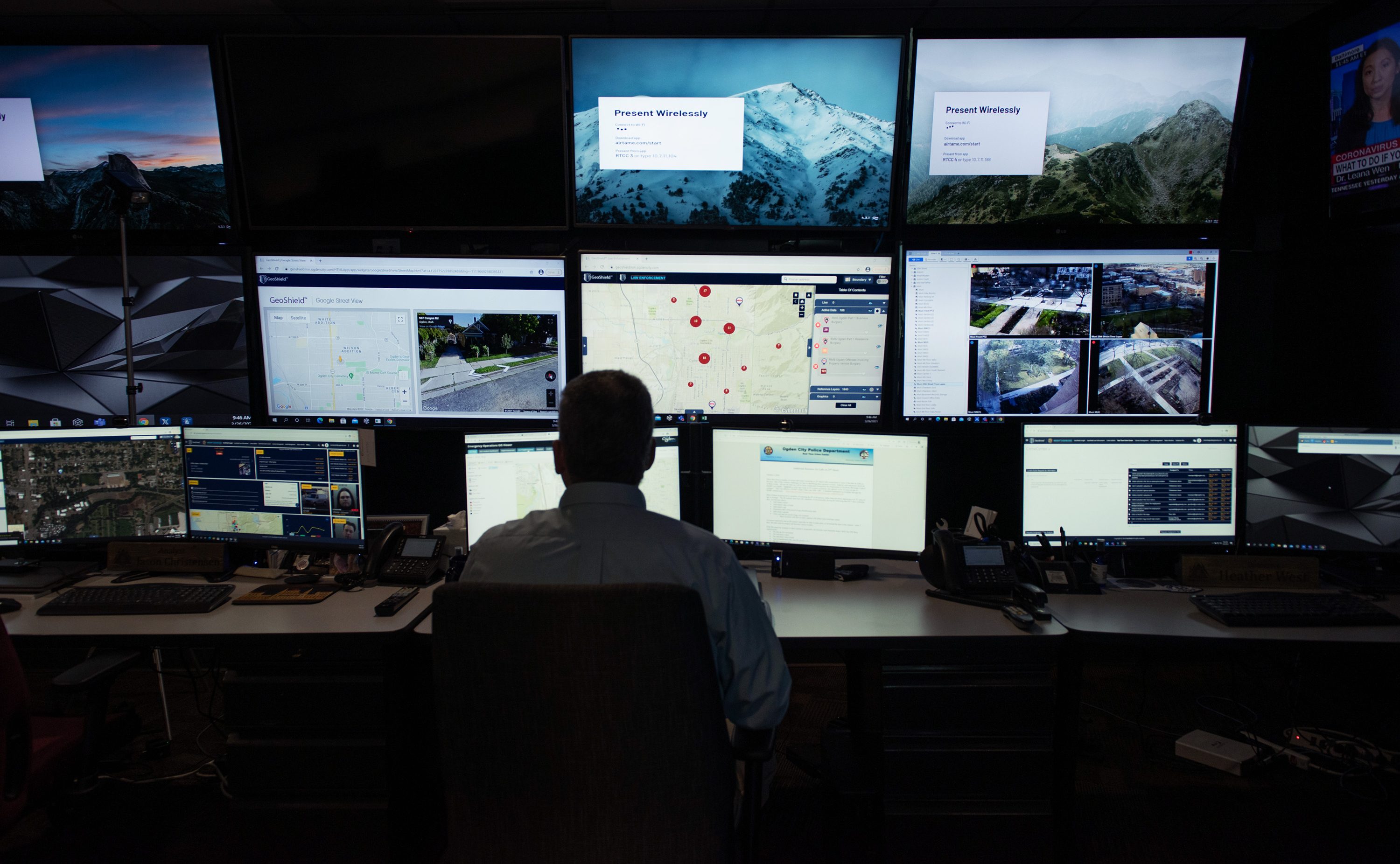
At a conference in New Orleans in 2007, Jon Greiner, then the chief of police in Ogden, Utah, heard a presentation by the New York City Police Department about a sophisticated new data hub called a “real time crime center.” Reams of information rendered in red and green splotches, dotted lines, and tiny yellow icons appeared as overlays on an interactive map of New York City: Murders. Shootings. Road closures. You could see the routes of planes landing at LaGuardia and the schedules of container ships arriving at the mouth of the Hudson River.
In the early 1990s, the NYPD had pioneered a system called CompStat that aimed to discern patterns in crime data, since widely adopted by large police departments around the country. With the real time crime center, the idea was to go a step further: What if dispatchers could use the department’s vast trove of data to inform the police response to incidents as they occurred?
Back in Ogden, population 82,702, the main problem on Greiner’s mind was a stubbornly high rate of vehicle burglaries. As it was, the department’s lone crime analyst was left to look for patterns by plotting addresses on paper maps, or by manually calculating the average time between similar crimes in a given area. The city had recently purchased license-plate readers with money from a federal grant, but it had no way to integrate the resulting archive of images with the rest of the department’s investigations. It was obvious that much more could be made of the data on hand.
“I’m not New York City,” Greiner thought, “but I could scale this down with the right software.” Greiner called a former colleague who’d gone to work for Esri, a large mapping company, and asked what kinds of disparate information he might put on a map. The answer, it turned out, was anything you could put in a spreadsheet: the address history of people on parole—sorting for those with past drug, burglary, or weapons convictions—or the respective locations of car thefts and car recoveries, to see if joyrides tended to end near the joyrider’s home. You could watch police cars and fire trucks move around the city, or plot cell-phone records over time to look back at a suspect’s whereabouts during the hours before and after a crime.
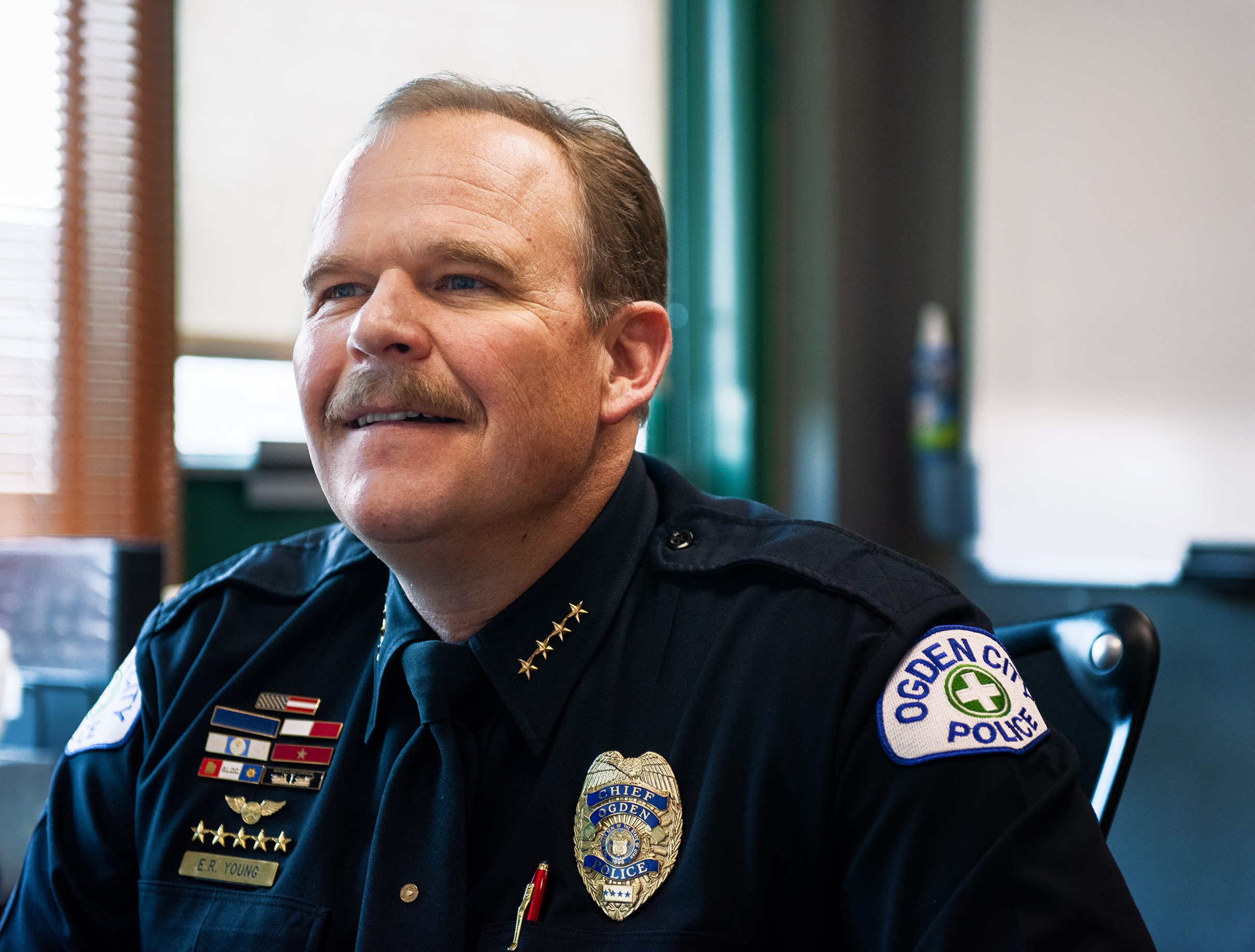
In 2021, it might be simpler to ask what can’t be mapped. Just as Google and social media have enabled each of us to reach into the figurative diaries and desk drawers of anyone we might be curious about, law enforcement agencies today have access to powerful new engines of data processing and association. Ogden is hardly the tip of the spear: police agencies in major cities are already using facial recognition to identify suspects—sometimes falsely—and deploying predictive policing to define patrol routes.
“That’s not happening here,” Ogden’s current police chief, Eric Young, told me. “We don’t have any kind of machine intelligence.”
The city council rebuffed Greiner’s first funding request for a real time crime center, in 2007. But the mayor gave his blessing to pursue the project within the existing police budget. Greiner approached Esri and flew down to the company’s headquarters in Redlands, California. He “started up a little friendship” with Esri’s billionaire cofounder, Jack Dangermond, and spoke at the company’s convention, floating a plan to fly a 30-foot camera-equipped blimp over Ogden to monitor emergencies as they developed. (“I got beat up by Jay Leno for that,” Greiner said. The blimp never launched.) Since Ogden already had a subscription to Esri’s flagship product, ArcGIS, which it used for planning and public works, the company offered to build a free test site for a real time crime center (RTCC).
Around the country, the expansion of police technology has followed a similar pattern, driven more by conversations between police agencies and their vendors than between police and the public they serve. The Electronic Frontier Foundation, an advocacy group that tracks the spread of surveillance technology among local law enforcement agencies, currently counts 85 RTCCs in cities as small as Westwego, Louisiana, whose population has yet to crack 10,000. I traveled to Ogden to find answers to a question Greiner phrased this way: “What are we gonna do with this new tool that gets really close to your constitutional rights?” And as federal and state laws take their time to catch up to the wares on offer at conventions like Esri’s, who gets to decide how close is too close?
Ogden grew up in the late 19th century, the junction nearest to the spot where the two halves of the transcontinental railroad were finally stitched together in 1869. Marketed at the time as the “crossroads of the West,” it sits at the seam between two of the region’s defining natural features. On one side, the Wasatch Mountains form the westernmost edge of the Rockies; on the other, the Great Basin extends outward from the shores of the Great Salt Lake. Ogden’s mayor, Mike Caldwell, likes to say the railroad made Ogden “rich at the right time.” But the railroad also brought an unsavory reputation it is still trying to overcome. Local legend has it that Al Capone stepped off a train in the 1920s, did a lap around 25th Street, and declared Ogden too wild a town for him to stay. By the time Jon Greiner took over as police chief in 1995, the main challenges on 25th Street were panhandling and public drunkenness. Still, the city’s leadership sees the real time crime center as a linchpin of efforts to revitalize its downtown.
What’s much harder to evaluate is how the use of surveillance tools affects the relationship between officers and the residents they encounter in their daily rounds.
The RTCC occupies a dim triangular office on the second floor of the city’s public safety building. Much of the light comes from twin monitors on each of six desks that wind their way along the wall, augmented by two rows of wall-mounted displays overhead. There’s a cell-phone extraction machine in the back corner, and several drones stacked in hard cases.
A team of seven analysts works in staggered shifts, monitoring police-radio traffic and working “requests for information” from detectives and patrol officers. Their supervisor, David Weloth, is a laid-back former detective with a neatly trimmed beard and a silver crew cut. Weloth retired from the Ogden City Police Department (OPD) in 2005, but he came back less than a year later to work as a crime analyst and has stayed on ever since.
When I arrived for a visit in February, OPD detective Heather West was scrolling through a queue of hundreds of photos captured by a new license-plate-reading system called Flock Safety, looking for a distinctive pickup truck—gray with a red camper shell—thought to have been used in a theft. The previous week, Weloth explained, Flock had helped the department recover five stolen vehicles in three days. Since they got it in December 2020, they’d queried the system more than 800 times. On searches without a plate number, though, looking for a particular kind or color of car, the algorithm had a tendency to veer off course. “For some reason, it likes red Mazda 3s,” West said, still looking at her screen.
Weloth introduced the team as Fox News played silently on a TV in the corner. West holds one of two OPD detective positions on the team, which also includes a sheriff’s deputy from surrounding Weber County and four civilian analysts with backgrounds in federal law enforcement. A former US Treasury officer was going through a statewide register of pawned goods, looking for matches with property reported stolen in Ogden.
Weloth had one of the analysts cue up a video from a recent homicide investigation, in which cell-phone records obtained by subpoena helped disprove key parts of a suspect’s story about his whereabouts on the night his girlfriend was murdered. Footage from a city-owned surveillance camera at Ogden’s water treatment plant allowed Weloth’s team to “put him where the phone said he was,” tightening the case for the prosecution.
This was one of a few greatest hits that came up repeatedly in discussions about how Ogden uses the technology in its real time crime center. In another, in 2018, analysts tapped into a network of city-owned cameras to locate a kidnapping suspect after the woman he’d held managed to flag down an officer and provide a physical description. When officers arrived on scene, the man shot at them; police returned fire and killed him.
If there’s any good reason to deploy invasive technology, surely solving a murder and stopping a violent crime both qualify. What’s much harder to evaluate is how the use of surveillance tools affects the relationship between officers and the residents they encounter in their daily rounds, or how they change the collective understanding of the purpose of policing.
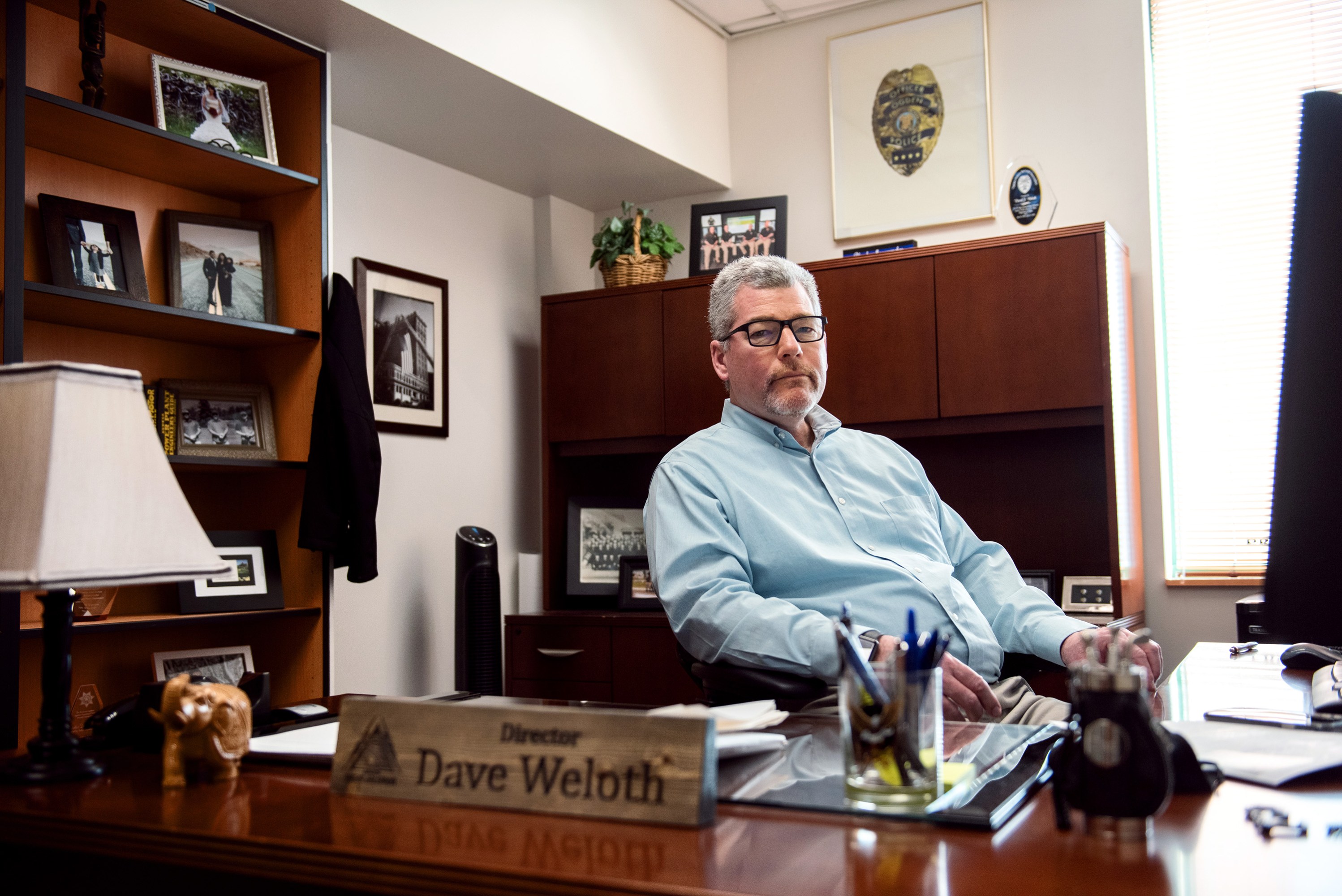
Take car theft. Recovering stolen cars has been an early success of the city’s network of license-plate readers. As Greiner recalled, thefts increase in the winter, “because people warm up their cars in the driveway, then go back inside and leave their keys in the ignition.” Today, Weloth told me, “running and unattendeds” still account for about a third of car thefts in the city. This includes an incident last November when a young mother left her 10-month-old in the back seat of her running car, which was stolen. Both the mayor and the chief of police told me the license-plate reader had been instrumental in finding the kid within two hours. But they didn’t mention that two women had found the baby crying on a front porch some miles away—and that the automatic reader had only helped them recover the car.
The police department maintains a web page advising residents on “10 Ways to reduce your vehicle from being stolen” and periodically sends community policing officers out to relay the message. Would a more robust public education program be a better way to reduce car theft than an intrusive citywide license-plate surveillance system? That’s not a question anyone at OPD appears to be asking.
When the RTCC launched, Weloth explained, his goal was to “close the gap between raw data and something that’s actionable.” To do that, he first had to figure out “What have we already paid for?” More than 100 city-owned surveillance cameras, installed by Ogden’s public works department after 9/11, were trained on sites like the parking lot of the fleet and facilities building, or the door to the city’s computer server room. In some places, the cameras could be controlled remotely. Analysts could review footage and pan, tilt, or zoom those cameras in accordance with requests from dispatch or officers in the field.
This is what had allowed Joshua Terry, who does much of the real time crime center’s mapping work, to follow along during the 2018 kidnapping call, zeroing in on a dark figure on the sidewalk in a Dallas Cowboys jacket seconds before he darted out of view. “That’s the reason we have it on,” Terry told me, playing back the footage of the incident on one of the big screens. The goal is not, he says, to constantly surveil everyone but to use what tools the analysts can to aid active investigations. “We couldn’t care less what people are doing,” he says, even though “people think we sit here watching these cameras.”
“I’d be bored to death,” a colleague said with a chuckle.
Besides, Weloth pointed out, the system had accountability: “I can tell exactly who moved what camera, where, when.”
When the state chapter of the American Civil Liberties Union called a city council member with concerns about the possible use of facial recognition, Weloth explained, he offered a tour of the RTCC. “We’re very cautious about stuff that’s not supported by law,” he said. “One mistake and we’re gonna pay the price.”
The challenge is that for much of police surveillance technology, the most relevant law is the Fourth Amendment prohibition on “unreasonable searches” of people’s “persons, houses, papers, and effects.” The court system has yet to figure out how this applies to modern surveillance systems. As Justice Sonia Sotomayor wrote in a 2012 Supreme Court opinion, “Awareness that the Government may be watching chills associational and expressive freedoms. And the Government’s unrestrained power to assemble data that reveal private aspects of identity is susceptible to abuse.”
Utah is one of 16 states with statutes that explicitly address automated license-plate readers; the OPD’s policy calls for two supervisors to sign off before querying a plate number against the database, and plate information can’t be stored for longer than nine months; it’s usually deleted within 30 days. Still, there’s no federal or state law that specifically regulates government use of surveillance cameras, and none of the department’s audits are published.
Sotomayor’s 2012 opinion was nonbinding (but widely cited), and it served mostly to point out that important issues haven’t been addressed in law. As Weloth had said when I first called to plan my visit, “We regulate ourselves extremely well.”
One afternoon, I accompanied Heather West, the detective who’d been perusing gray pickups in the license-plate database, and Josh Terry, the analyst who’d spotted the kidnapper with the Cowboys jacket, to fly a drone over a park abutting a city-owned golf course on the edge of town. West was at the controls; Terry followed the drone’s path in the sky and maintained “situational awareness” for the crew; another detective focused on the iPad showing what the drone was seeing, as opposed to where and how it was flying.
Of all the gadgets under the hood at the real time crime center, drones may well be the most tightly regulated, subject to safety (but not privacy) regulations and review by the Federal Aviation Administration. In Ogden, neighbor to a large Air Force base, these rules are compounded by flight restrictions covering most of the city. The police department had to obtain waivers to get its drones off the ground; it took two years to develop policies and get the necessary approvals to start making flights.
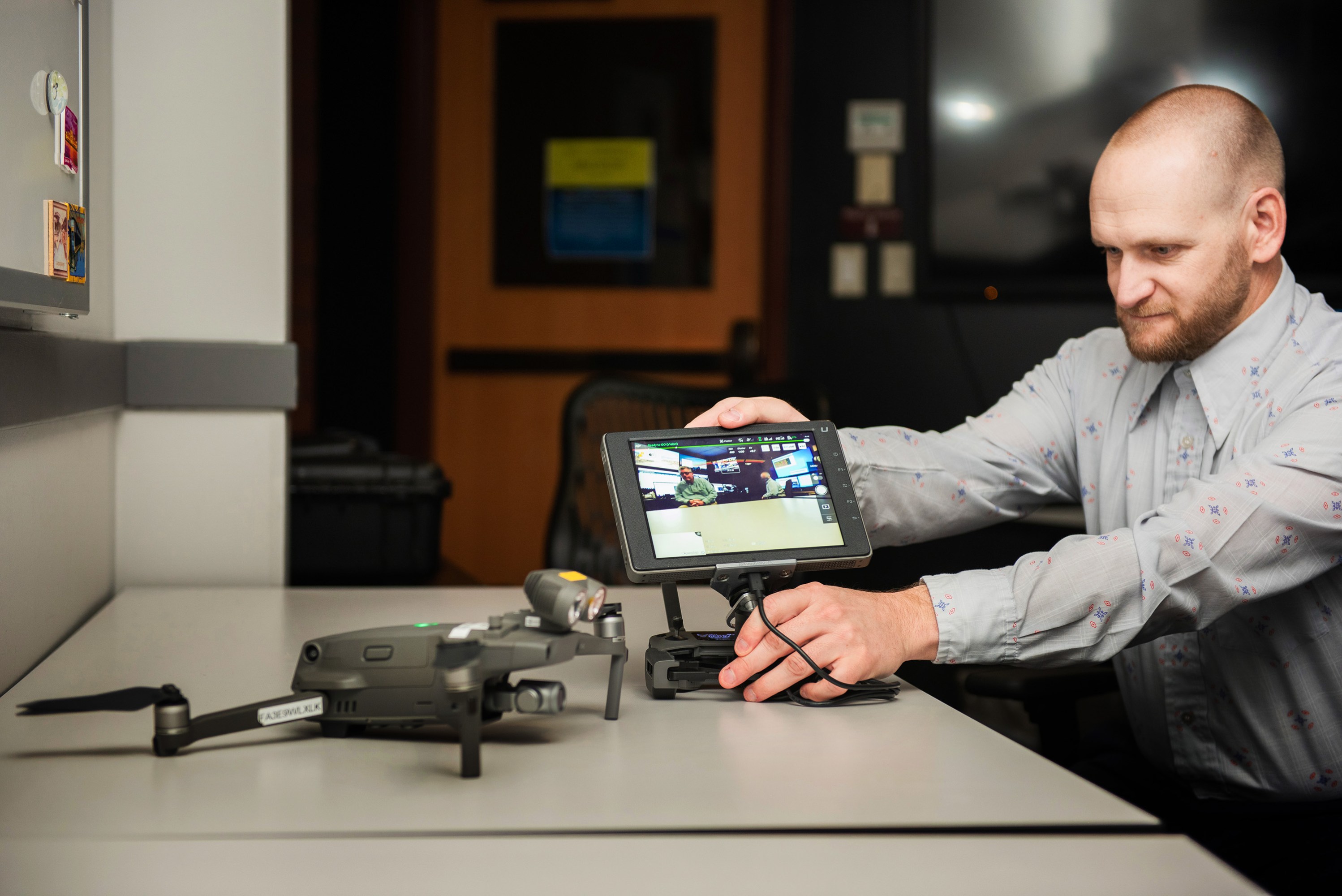
The police department purchased its drones with a mind to managing large public events or complex incidents like hostage situations. But, as Dave Weloth soon found, “the more we use our drones, the more use cases we find.” At the real time crime center, Terry, who has a master’s in geographic information technology, had given me a tour of the city with images gathered on recent drone flights, clicking through to cloud-shaped splotches, assembled from the drone’s composite photographs, that dotted the map of Ogden.
Above 21st Street and Washington, he zoomed in on the site of a fatal crash caused by a motorcycle running a red light. A bloody sheet covered the driver’s body, legs splayed on the pavement, surrounded by a ring of fire trucks. Within minutes, the drone’s cameras had scanned the scene and created a 3D model accurate to a centimeter, replacing the complex choreography of place markers and fixed cameras on the ground that sometimes leave major intersections closed for hours after a deadly collision.
No one seemed to give much thought to the fact that quietly, people who were homeless had become the sight most frequently captured by the police department’s drone program.
When the region was hit by a powerful windstorm last September, Terry flew a drone over massive piles of downed trees and brush collected by the city. When county officials saw the resulting volumetric analysis—12,938 cubic yards—that would be submitted as part of a claim to the Federal Emergency Management Agency, they asked the police department to perform the same service for two neighboring towns. Ogden drones have also been used to pinpoint hot spots after wildland fires, locate missing persons, and fly “overwatch” for SWAT team raids.
This flight was more routine. When I pulled into the parking lot, two officers from Ogden’s community policing unit looked on as West steered the craft over a dense stand of Gambel oak and then hovered over a triangular log fort on a hillside a couple of hundred yards away. Though they’d never encountered people on drone sweeps through the area, trash and makeshift structures were commonplace. Once the RTCC pinpointed the location of any encampments, the community service officers would go in on foot to get a closer look. “We get a lot of positive feedback from runners, hikers,” one officer explained. After one recent visit to a camp near a pond on 21st Street, he and the county social service workers who accompanied him found housing for two people they’d met there. When clearing camps, police also “try and connect [people] with services they need,” Weloth said. The department recently hired a full-time homeless outreach coordinator to help. “We can’t police ourselves out of this problem,” he said, comparing the department’s efforts to keep new camps from springing up to “pushing water uphill.”
Still, no one seemed to give much thought to the fact that quietly, people who were homeless had become the sight most frequently captured by the police department’s drone program. Of the 137 non-training flights made since May 2019, nearly half—62—were flyovers of homeless encampments, with regular flights over a parkway on the Ogden River and in woods by the railroad, whose owner, Union Pacific, employs its own private security as well. It was easy to see the appeal: if, instead of spending hours clambering through the woods, you could find people in minutes by looking down from on high, why not?
“We’ve had a lot of homicides come out of those illegal encampments,” Ogden’s mayor, Mike Caldwell, told me. Chief Young cited two incidents to support Caldwell’s claim. The first was the 2018 murder of a homeless man, whose killer told police he considered homeless people a “problem.” The second was a fatal stabbing in an encampment near the railroad tracks, just outside city limits; the suspect arrested in the case was homeless himself. Both incidents were tragic examples of the well-documented vulnerability to violence of people without shelter. But does it follow that drones would be an effective deterrent?
The idea that police were flying over the city’s open spaces to investigate homicides is also hard to square with the contention that the flights were part of the city’s homeless outreach. Aren’t those different activities, or shouldn’t they be? Either way, Caldwell said, “if it wasn’t the drone, it would be officers climbing over deadfall and going into those places. That keeps our officers safe, and gives us more bandwidth.”
One important function of resource constraints, though—bandwidth, in the mayor’s equation—is that they force governments, and citizens, to consider priorities. One Friday afternoon, I met Doug Young, a 49-year-old who has lived outdoors in Ogden on and off for the last 12 years. He wore a gray poncho and a cowboy hat with a pin in the shape of a cow’s skull. Young said he often saw drones overhead when he camped behind a local Walmart, and he had learned to distinguish police drones by the whirr of their motors. “If it stops violent crime, cool. If it’s for some petty bullshit, leave us the fuck alone,” he said.
To Mayor Caldwell, this wasn’t a meaningful distinction. Asked whether there were some complaints or alleged crimes that weren’t serious enough to justify use of the RTCC’s most invasive technologies, he said, “I think we should use all the tools … The average everyday person wouldn’t even know that these tools are out there or that anything is being monitored.”
For Betty Sawyer, president of the Ogden chapter of the NAACP, that’s precisely the problem. Sawyer told me she wasn’t aware the city had license-plate readers and remotely monitored surveillance cameras until I called her for an interview. When she asked the department for more information, Chief Young shared a presentation he’d made before the City Council in December—one week before the new license-plate readers were deployed. “How many people are listening to weekly city council meetings?” she asked. “If no one’s talking about it but it’s here—how, why, what’s the reason for it? Is that the best use of our dollar when we’re down officers? These are things that should be put up front, not after the fact.”
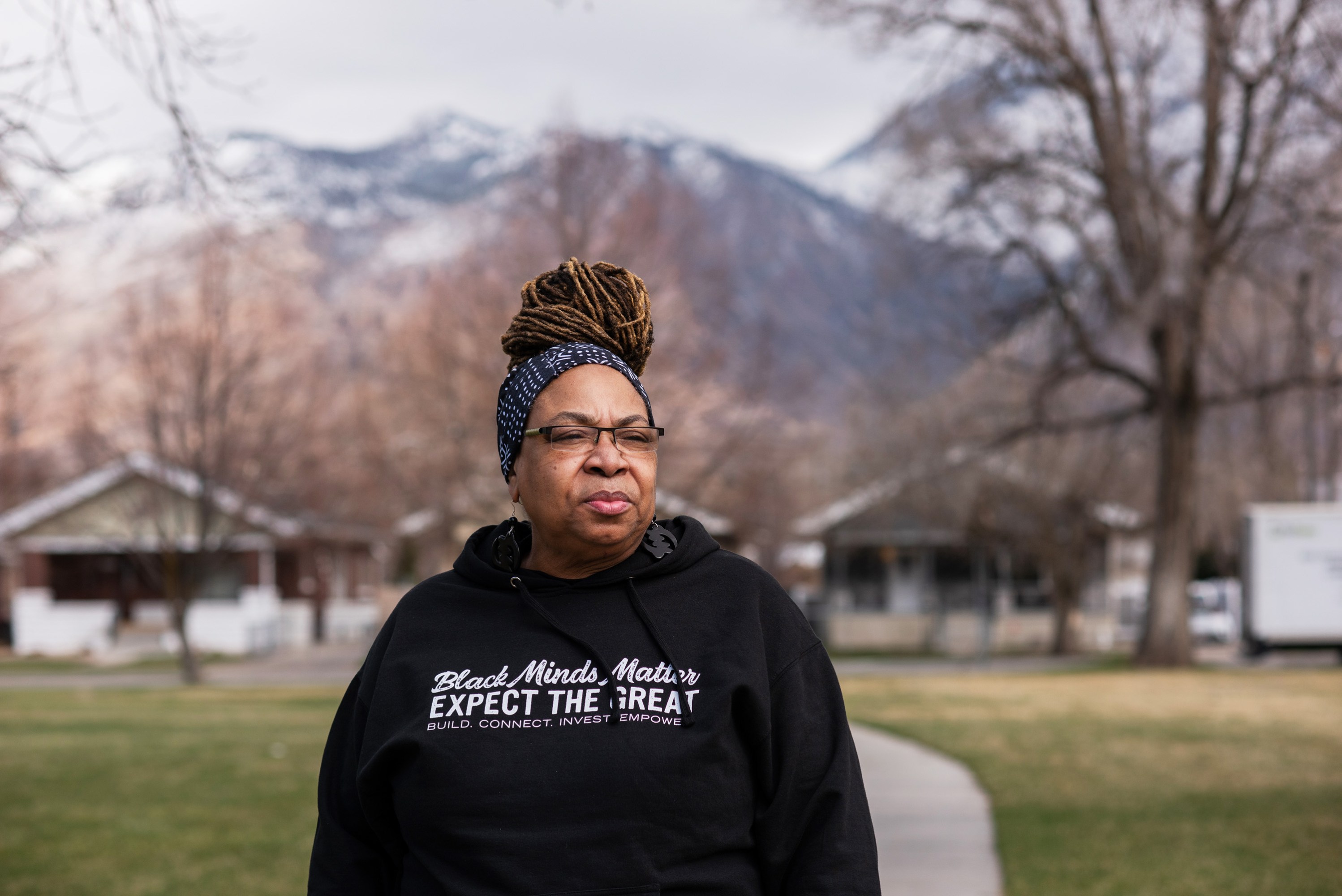
Last summer, as protests flared across the country in response to the police killing of George Floyd in Minneapolis, Sawyer spearheaded a group that held a series of meetings with the mayor and police chief. It was an effort to improve police--community relations in a city where no Black cop serves in a department of 126 sworn officers, and where the police force is less than 10% Hispanic, though Hispanic residents make up more than 30% of Ogden’s population. “Our whole goal is: How do we build in transparency so we can dispel the myths and speak to the truth of what you are doing?” she said.
One risk for the police department is that the RTCC’s usefulness is, at least for some of the city, ultimately overshadowed by mistrust over cops’ ability to use their new powers with restraint. As Malik Dayo, who organized several Black Lives Matter protests in Ogden last summer, told me, “I can leave my house, drive to the store, and come back, and if [police] wanted to, they can figure out what time I left, what time I came back, and if I made any stops along the way.” Some cities have preempted similar objections with an avalanche of public data: in Southern California, the city of Chula Vista publishes routes and accompanying case numbers for every drone flight its police department conducts. Weloth assured me the checks and balances on Ogden’s license-plate readers would prevent the scenario Dayo described. Dayo was unmoved. “I think it’s gonna be abused,” he said. “I really do.”
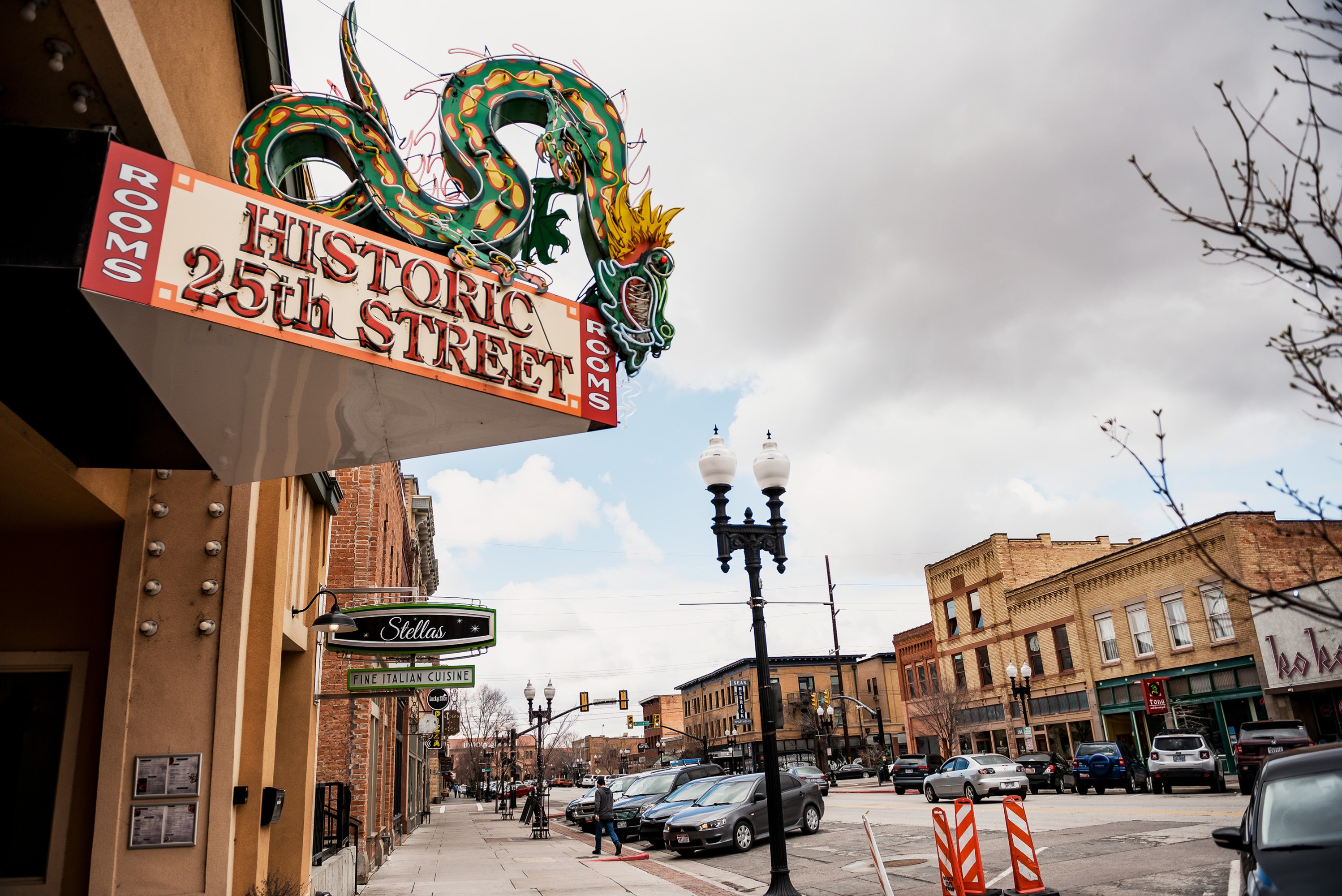
Police tend to view all the tools at their disposal as part of the same basic continuum—drones and bicycles alike helping “to protect and serve.” After a few days in Ogden, though, I couldn’t help but think that the RTCC’s tools were also functioning as a kind of digital armor for a particular worldview. Was the department’s reliance on technology allowing it to do more with less, or was it letting the city ignore the complexities of its most urgent social problems?
Last August, a covid-19 outbreak at the Lantern House, Ogden’s largest homeless shelter, infected at least 48 residents and killed two. Confirmed cases were quarantined in a separate wing of the shelter, but people soon began to set up tents on the sidewalk outside, where 33rd Street dead-ended by the railroad tracks.
Among them was a man who asked me to use only his first name, Ryan, and said he no longer felt safe sleeping on closely spaced bunks: “You’re within four feet of five people.” Outside, people had to move their stuff twice a week for workers to clear trash, and sometimes human waste, from the area—there were no dumpsters, and no porta-potties—but it felt safer than being indoors. “We were staying so close together it was a health risk,” he said.
The police department set up a trailer with surveillance cameras atop a high pole to record what happened in the new camp. Through the fall, as the group living outside the shelter swelled to some 60 people in about 30 tents, the cameras captured several incidents of violence. A car window was smashed. Someone punched a pizza delivery driver in the face.
On December 10, a Thursday, a team including police, firefighters, and county social workers cleared the encampment once and for all. “Up to this point, Ogden city has taken a moderated approach during the pandemic. However, the situation has now become untenable,” a city press release read, identifying the encampment as a source of crime and a drain on city resources.
“Given the potential for the spread of COVID-19 and other communicable diseases often found in camps like these, risks from camp members spread throughout the city.” This was not the approach advocated by the Centers for Disease Control, which recommends that local governments “allow people who are living unsheltered or in encampments to remain where they are,” emphasizing that dispersing encampments increases potential for disease spread.
According to a report in the local paper, 10 people accepted the city’s offer to go sleep inside the Lantern House, and the rest dispersed. If they found themselves setting up tents along the Ogden River, they’d be spotted soon enough by one of the police department’s drones.
Paige Berhow, who retired as assistant police chief in the Ogden suburb of Riverdale and now lives in the city, became an officer in the early 1980s, when her on-duty equipment consisted of little more than a uniform and a revolver. Then came tasers and bulletproof vests and computer dashboards in every patrol car. “With every layer of stuff, that’s another layer of detachment from the public, too,” she told me. As Berhow pointed out, much of the expanding footprint of technology in police departments has come in the name of officer safety, though on-duty officer deaths have declined dramatically over the last several decades.
David Weloth hesitated when I asked what would change, 10 years into Ogden’s experiment, if the police department suddenly had to do without the RTCC, since renamed the Area Tactical Analysis Center. “We would have a very difficult time,” he said. “There’s no crime reduction strategy that happens without ATAC.”
“There’s no crime reduction strategy that happens without ATAC.”
David Weloth
ATAC’s role in the police department’s relationship with the city has steadily expanded over time. The number of “requests for information” completed by the group was up by over 20% last year. The police department now has a say in the city’s master plan for surveillance cameras; the popularity of Amazon Ring’s camera--equipped doorbells, meanwhile, has given analysts a new trove of data to peruse.
But Ogden releases very little data to shed light on ATAC’s role, beyond confirmation that it’s still growing. In the fall of 2019, when the city launched an expanded network of surveillance cameras that ATAC could monitor remotely, employees accessed them only a handful of times each month. They soon found reasons to peer through the cameras daily. From November 23, 2020, to February 23, 2021 (the most recent three months for which the city provided data), ATAC processed over 27,000 queries, or about 300 each day.
Suresh Venkatasubramanian, a computer scientist at the University of Utah who studies the social implications of algorithmic decision-making, worries that police departments have embraced novel tools without the resources or the expertise to properly evaluate their influence. How might the distribution of surveillance cameras, for instance, affect the department’s understanding of the distribution of crime? How could software like that sold by Palantir (a data analytics firm with roots in the intelligence community) amplify existing biases and distortions in the criminal justice system? “A lot of government agencies who are getting solicited by vendors would like … to scrutinize them properly, but they don’t know how,” he told me. “The idea coming from vendors is that more data is always better. That’s really not the case.”
To their credit, the analysts working at ATAC made good on Weloth’s pledge of openness. They were candid, and willing to explore potential pitfalls in their work. Terry, who did much of the mapping work at ATAC, had spent four years as a contractor with the National Geospatial-Intelligence Agency working on American drone strikes. He told the story of a fellow image analyst who misidentified what he thought was a group of men making IEDs under cover of darkness. On the strength of that analysis, Terry says, “they blew up kids carrying firewood.” When Terry came to Ogden, he was surprised to see that local police departments had access to tools as powerful as Palantir’s. Another analyst swiveled in his chair and chimed in. “The technology is getting better and the cost is coming down,” he said. “At some point will we get access to technology we regret having? Probably.”
Rowan Moore Gerety is a writer in Phoenix, Arizona.
Deep Dive
Policy
A brief, weird history of brainwashing
L. Ron Hubbard, Operation Midnight Climax, and stochastic terrorism—the race for mind control changed America forever.
Why the Chinese government is sparing AI from harsh regulations—for now
The Chinese government may have been tough on consumer tech platforms, but its AI regulations are intentionally lax to keep the domestic industry growing.
AI was supposed to make police bodycams better. What happened?
New AI programs that analyze bodycam recordings promise more transparency but are doing little to change culture.
Eric Schmidt: Why America needs an Apollo program for the age of AI
Advanced computing is core to the security and prosperity of the US. We need to lay the groundwork now.
Stay connected
Get the latest updates from
MIT Technology Review
Discover special offers, top stories, upcoming events, and more.